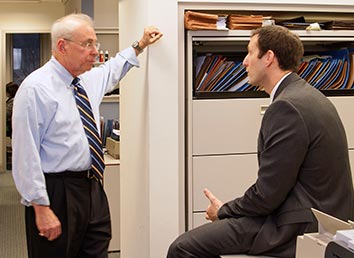SE HABLA ESPAÑOL
How Using Will Substitutes Can Streamline Post-Death Transfer of Assets
2024
by: Bulman, Dunie, Burke and Feld, CHTD
Category: Estates and Trusts

Many clients come to an estate planning consultation with a belief that a Last Will and Testament is the tool that disposes of their assets after they have passed away.
Assets that transfer to your heirs via a Will must go through the court-supervised process called “probate”. Probate takes – in its most streamlined form – 6+ months to complete.
What many clients do not realize is that there are other convenient and – sometimes much faster ways – to transfer assets to your loved ones after you die. These processes are often called “will substitutes”.
Through the use of will substitutes, you may be able to minimize the scope of assets that will have to go through probate after you die and truly make things easier on your loved ones.
Beneficiary Designations
Many assets that you hold, such as investment accounts, retirement accounts, and life insurance policies, allow you to fill out a beneficiary designation form when you open the account. Some financial institutions and insurers require that you complete a beneficiary designation form.
These forms identify the person or persons who you would like to receive that asset upon your death. These designations are also commonly referred to as pay-on-death designations, “POD” designations, transfer-on-death designations, or “TOD” designations.
Beneficiary designations can be completely personalized, despite what the standard-issue form you are completing might indicate. You can split up an asset into as many equal or unequal shares as you would like, identify multiple people that you would like to transfer the asset to and identify backup (“contingent”) beneficiaries if one of the people you have identified has predeceased you. Additionally, these designations can be updated whenever you desire.
Not only can these designations be completely personalized, but the asset transferring via beneficiary designation can transfer to the beneficiary much faster than if the asset must go through the probate process. After you pass away, many institutions simply require the beneficiary to provide a copy of your death certificate, and the institution will initiate the transfer of the asset to the designated beneficiaries. This process can take weeks, as opposed to months.
Beneficiary designation forms are sneakily important. The beneficiary designation form is effectively the “will” for that particular asset. It governs the post-death transfer of that asset. If there is a conflict between your Will and the beneficiary designation, the beneficiary designation will most likely control.
Jointly-Owned Property
Similarly, an asset co-owned with a joint owner will not pass via your Will. Rather, the asset transfers immediately to the surviving joint owner, avoiding the probate process.
This can come in handy for bank accounts if you intend on passing the contents of a bank account to someone after you pass.
Many married couples own real estate as “tenants by the entirety”. This type of ownership works similarly to joint ownership. Upon the passing of the first spouse, the surviving spouse will automatically own the property, without the need for the property to go through the probate process.
Two important notes about joint ownership:
First, if you own an asset with another as a “tenant in common”, this is NOT joint ownership. Rather, you each have a designated share of the asset. True joint ownership, referred to as “joint owners with right of survivorship” or “tenants by the entireties” means that each co-owner is presumed to own the whole.
Second, many clients ask about adding a child as a co-owner to a bank account or home to streamline the transfer of that asset. Carefully discuss this with your estate planning attorney. There may be disadvantages to you or to your children of this approach, including losing tax advantages and creditor protection.
Living Trusts
An asset that is held in a living trust (or which flows to the living trust by beneficiary designation) will not transfer via your Will and will not be exposed to probate.
As such, clients may choose to use a living trust to hold title to real estate or other assets. A living trust is the primary vehicle whereby married couples can ensure that jointly-owned real estate does not go through probate after the second death.
The primary downside to a living trust is the initial expense. A living trust does cost more to draft and implement than a Will, both in terms of the drafting and in terms of the retitling of real estate into the trust. However, the initial cost of creating and funding the trust will almost always be less than the post-death cost of probate. It is, quite simply, a decision for our planning clients as to whether they want to spend time and money now to avoid their children (or other loved ones) incurring costs and fees in probate down the road. And there is no right or wrong answer!
So What DOES Pass Via Your Last Will and Testament?
Simply put, only an asset that you own in your sole name at the time of your death without a designated pay-on-death (or transfer-on-death) beneficiary will pass via your Will and go through probate.
For many clients, who skillfully use beneficiary designations and other will substitutes, the only asset that will pass via your Will and be exposed to probate is real estate and the tangible property located in the real estate – and even then – only if you are the second to die of you and your spouse.
The method to avoid real estate and tangible property passing via you Will and going through probate is to transfer these assets to a living trust.
Concluding Thoughts
The strategic use of will substitutes is a very effective way to avoid probate. And, to many of our clients surprise, will result in an outcome where very few – if any – assets will eventually pass via their Last Will and Testament.
And about those beneficiary designation forms that you likely filled out in haste many years ago – perhaps before marriage or children – and have forgotten about: now is a great time to review your Estate Planning to determine whether you have a beneficiary designation on file for an asset, who you have selected as the designated beneficiary, and whether any changes are necessary.
How can we help you ensure the smooth and prompt transfer of your nest egg after your death? Contact estate planning attorney Elizabeth Farley at lfarley@bulmandunie.com or (301) 656-1177 for easy-to-understand guidance!
SE HABLA ESPAÑOL
Talk to an Experienced Attorney
301-656-1177





0 Comments